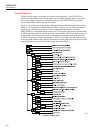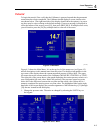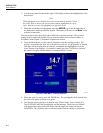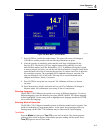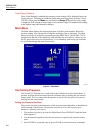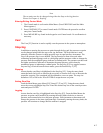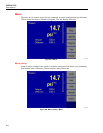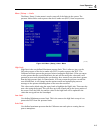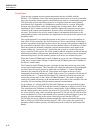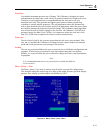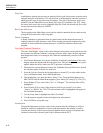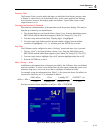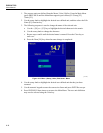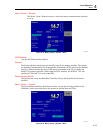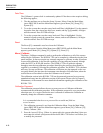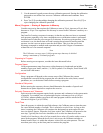
RUSKA 7350
Users Manual
4-10
Control Band
There are two common pressure control approaches that are available with the
RUSKA 7350 Calibrator. One of the most common control styles is an Active controller
where the controller remains operative and holds the pressure at a commanded set-point.
This allows the system to hold the pressure at a set-point within the control stability
specification (See Appendix A). In addition to possible leaks in a system, following a
pressure step, the pressure in the system changes due to temperature effects. When
operating an Active control system, the controller continuously monitors any pressure
variances in the system and compensates for these effects to hold the pressure at the
set-point. The benefit of the Active control is that it can maintain the pressure at the
commanded set-point even when there are slight leaks in the system or the system is not
thermally stable.
The second approach is to control the pressure in the system to a set-point and then to
shut-off the Active controller. We describe this as a Passive control mode. Following a
pressure step and the controller becomes passive, the pressure will continue to change in
the system due to thermal effects. However these thermal effects will stabilize over time.
Once the system has thermally stabilized, pressure measurements can be made in the
system without any “pressure noise” injected into the system as a result of having an
Active controller in the system. The result would be that the controller would not add any
additional uncertainty to the pressure measurement since it would be inactive during the
measurement process. For this method, pressure will not be at a cardinal set-point.
When the Control Off Band and Control On Band are set to zero, the Calibrator operates
in the Active control mode. Setting a Control On and Off Band, places the Calibrator in
the Passive control mode.
The Control On and Off Band provides a tolerance around the pressure set-point in the
current unit of measurement. The Controller will control the pressure to the commanded
set-point. Once the actual pressure is within the user defined +/- Control Off Band
tolerance, the controller will shut off. The pressure will remain at this level, only
changing by the thermal influences or leaks in the system. The controller will remain off
until it reaches the +/- Control On Band limit. The controller will then re-activate and
control the pressure back to the Control Off Band tolerance. This mode of operation
removes any added uncertainty in the measurement system due to the controller since the
controller is Passive during the high accuracy pressure measurements.
As an example, if a 100 psi (690 kPa) full scale Calibrator was set-up with the Control
Off Band at 0.001 psi (0.007 kPa) and the Control On Band set to 0.005 psi (0.035 kPa).
This would place the Calibrator in a Passive control mode. If the Calibrator was placed
into the control mode with a pressure set-point of 10 psi (69 kPa), it would control up to
the 10 psi (69 kPa) value. Once it reached a pressure of 9.999 psi (68.993 kPa) the active
control would turn off. Due to the thermal effects caused by pressurizing the system, the
pressure will start reducing in the system. Once the pressure reaches 9.995 psi
(68.965 kPa) the active controller would automatically turn on and control the pressure
back to 9.999 psi (68.993 kPa) and then turn off. After a few cycles, the system will
thermally stabilize and the pressure will hold between the Control On and Control Off
Bands.



